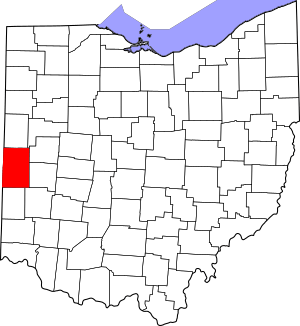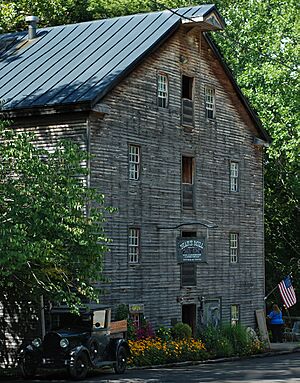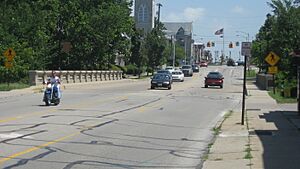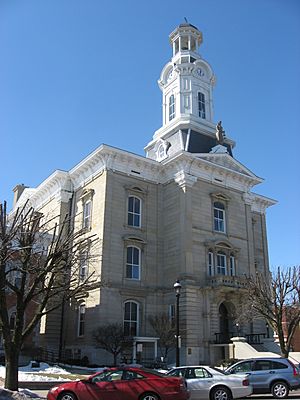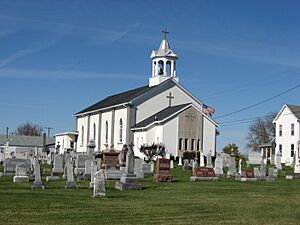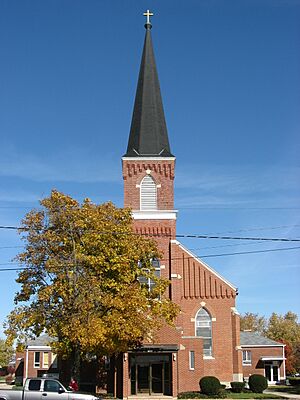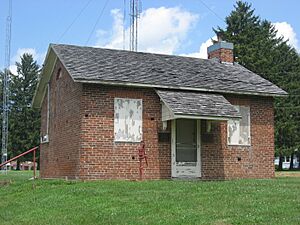National Register of Historic Places listings in Darke County, Ohio facts for kids
Welcome to Darke County, Ohio! This page is all about the special places in Darke County that are listed on the National Register of Historic Places. Think of this register as a very important list of buildings, sites, and objects across the United States that are worth saving because of their history, architecture, or what they mean to the local community.
In Darke County, Ohio, there are 26 different places on this special list. These places help us learn about the past and understand how people lived long ago. They include old mills, historic homes, churches, and even a courthouse!
Contents
What is the National Register of Historic Places?
The National Register of Historic Places is the official list of the nation's historic places that are considered worthy of preservation. It's like a hall of fame for important historical sites. When a place is added to this list, it means it has a special story to tell about American history, architecture, archaeology, engineering, or culture.
Why are places added to the list?
Places get added to the National Register for many reasons. Maybe they are very old and show how buildings were made a long time ago. Perhaps an important person lived there, or a big historical event happened there. Sometimes, a place is special because it represents a certain style of building that was popular in the past.
Who decides what gets listed?
Experts in history, architecture, and archaeology decide which places are important enough to be on the list. They look at how old a place is, its condition, and its connection to history. Being on the list helps protect these places and makes people more aware of their value.
Historic Places in Darke County
Let's explore some of the fascinating historic places you can find in Darke County, Ohio. Each one has its own unique story!
Bear's Mill: A Glimpse into the Past
One of the oldest and most interesting places is Bear's Mill, located east of Greenville, Ohio. This mill was built way back in 1849. It's a gristmill, which means it was used to grind grain into flour. Imagine farmers bringing their crops here over 170 years ago! Today, it's one of the few water-powered mills still working in Ohio. It's a great place to see how things were done before modern machines.
Greenville's Historic Buildings
The city of Greenville has many buildings on the National Register, showing its rich history.
Anna Beir House: A Home from the Past
The Anna Beir House on East 4th Street in Greenville is a beautiful old home. It was built in 1877 and is a great example of the homes people lived in during the late 1800s.
Broadway Bridge: Connecting History
The Broadway Bridge crosses over Greenville Creek. This bridge isn't just for cars; it's a piece of history! It was built in 1901 and shows the engineering skills of that time.
Carnegie Library and St. Clair Memorial Hall
The Carnegie Library and Henry St. Clair Memorial Hall are two important buildings in Greenville. The Carnegie Library was built with money donated by Andrew Carnegie, a famous businessman who helped build many libraries across the country. These buildings have been important centers for learning and community events for a long time.
Darke County Courthouse: A Center of Justice
The Darke County Courthouse, Sheriff's House and Jail is a grand building at 4th and Broadway. Built in 1874, it's where important decisions for the county have been made for over a century. Its impressive architecture makes it stand out.
Garst Museum: Preserving Local Stories
The Garst House, now known as the Garst Museum, is another significant spot. This museum helps preserve the history of Darke County, telling stories of famous people like Annie Oakley and the Treaty of Greenville.
Greenville Mausoleum: A Place of Remembrance
In the Greenville Cemetery, you'll find the Greenville Mausoleum. Built in 1913, this structure is a beautiful example of early 20th-century design, providing a peaceful resting place.
Greenville South Broadway Commercial District
This district includes many historic shops and buildings along South Broadway. It shows how the downtown area of Greenville looked and functioned as a busy center for business and community life in the past.
Churches with Rich History
Several churches in Darke County are also on the National Register, highlighting their importance to the community and their beautiful architecture.
Holy Family Catholic Church in Frenchtown
The Holy Family Catholic Church in Frenchtown, built in 1866, is a stunning example of church architecture from that era. It has served its community for many generations.
St. Louis Catholic Church in North Star
The St. Louis Catholic Church and Rectory in North Star, built in 1893, is another beautiful church with a long history. Its tall spire is a landmark in the area.
St. Nicholas Catholic Church in Osgood
In Osgood, the St. Nicholas Catholic Church and Rectory stands as a testament to the community's faith and history. This church, built in 1906, features impressive stained glass and detailed craftsmanship.
St. Peter Evangelical Lutheran Church near Versailles
South of Versailles, the St. Peter Evangelical Lutheran Church was built in 1888. It's a lovely example of a rural church that has been a spiritual home for many families over the years.
Other Notable Historic Sites
Darke County is home to many other unique historic places.
Fort Jefferson Site: An Early Military Post
The Fort Jefferson Site is a very important historical location. This was once a military fort built in 1791 during the Northwest Indian War. It played a key role in the early history of Ohio and the United States.
Studabaker-Scott House and Beehive School
South of Greenville, you'll find the Studabaker-Scott House and Beehive School. The Beehive School, built in 1856, is a one-room schoolhouse. Imagine all the children who learned to read and write in that very room! It gives us a great idea of what education was like long ago.
Versailles Town Hall and Wayne Township House
In Versailles, Ohio, the Versailles Town Hall and Wayne Township House has been a central point for local government and community activities since it was built in 1902.
Images for kids


